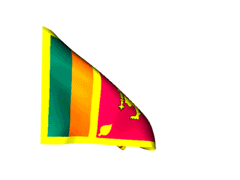Junk awash in tsunami hit Sri Lanka. What the future holds for the nation and its people. – By Aubrey Joachim

 On Boxing Day 2004 Sri Lanka was hit by the massive Indian Ocean tsunami. Over 31 thousand persons were confirmed dead, over 4 thousand were missing and some 21 thousand were injured. There was massive damage to property and the images of death, destruction and junk still haunt Sri Lankans’ memories. A little over 17 years on the ‘teardrop isle’ has been hit by an even bigger tsunami in the form of a wave of debt and destruction. This time the resulting junk is the status of Sri Lanka and its central and commercial banks littered across the global financial markets landscape. Even its airline is not spared.
On Boxing Day 2004 Sri Lanka was hit by the massive Indian Ocean tsunami. Over 31 thousand persons were confirmed dead, over 4 thousand were missing and some 21 thousand were injured. There was massive damage to property and the images of death, destruction and junk still haunt Sri Lankans’ memories. A little over 17 years on the ‘teardrop isle’ has been hit by an even bigger tsunami in the form of a wave of debt and destruction. This time the resulting junk is the status of Sri Lanka and its central and commercial banks littered across the global financial markets landscape. Even its airline is not spared.
Just like the 2004 tsunami which started thousands of kilometres away before crashing into the island as a destructive wall of water, the current wall of misery that has crushed Sri Lanka has been many years in the making. It has now eventuated into a US$ 52 Billion Dollar – and growing, wall of debt that is causing mayhem and misery to millions of Sri Lankans. Just like 2004. The images of the wailing and chanting populace scattered across the country and in global locations where there are Sri Lankan diaspora will long live in the memories of an entire generation of Sri Lankans. The 21st century social media technology will ensure its perpetuity.
While the 22 million domiciled Lankans will shoulder the heaviest burden over the many years ahead, Sri Lankans all over the globe will also have to share in that purgatory as they provide support to family and friends back home. And this scenario unfortunately will last a very long time.
Let us examine the situation. The current debt mountain is in the order of US$ 52 Billion. Unless the lenders are willing to forego some of the debt or interest – by way of what is being referred to as a ‘hair-cut’ this number will steadily grow over the next few years as unpaid interest is also adding to the loan amount. Even if re-structured the quantum of debt will grow as the can is merely kicked down the road. The agony is prolonged. It is doubtful that any good Samaritan nation will step in with a handout. If the IMF comes to the party it too would initially grant a meagre loan of some sort (US$ 395 Million is the figure talked about) to temporarily keep things going which also adds to the debt mountain. Any further larger loan amounts – US$ 3-4 Billion as is being requested by the Sri Lankan Finance Minister – will require substantial proof of debt sustainability in the form of assurances of significant measures for Sri Lanka to put its financial house in order. This is the worrisome burden Sri Lankans will have to bear for many years to come. Much has been written and spoken about how the country got to this point and there is no point replaying that story. The only way that Sri Lanka can get out of this gigantic hole is by itself – and the IMF will insist upon it doing that. The other option is to sell off the silverware. This option is also being talked about but the fire-sale value of such disposable assets will come nowhere near the height of the debt mountain.
So to a probable solution. Getting out of a hole – especially one dug by oneself is not easy. Two steps up one step back they say. For a start Sri Lanka must balance things from an in-country perspective local revenues – mainly taxes – must balance local spend. Therefore, in order to raise revenues direct and indirect taxes will need to be raised – fairly significantly which will impact on people’s residual incomes. On the cost side superfluous public service jobs will have to be reduced. Even the oversized military will have to be trimmed. Thus the significant joblessness will create poverty and increase crime. The current subsidies in areas such as energy, transport etc. will have to be eliminated. Public services such as transport, health and education will have to be maintained but at minimum acceptable levels. Rationing of food and other staples and even fabric will be the order of the day and overall people will have to do with less. It’s hard to stimulate productivity in under such conditions.
And what about all the loss making State Owned Enterprises? For years these have been a drain on the country’s finances. Can or should a country in this dire state maintain a massive loss-making flag career? Sri Lankan has amassed losses of SLR 374 Billion since parting ways with Emirates. Hard decisions will need to be made.
Balancing the country’s external trade deficit is the more challenging issue. Sri Lanka depends heavily on the imports of its basic commodities such as fuel, medicines and medical equipment, food items – rice, lentils, sugar, milk powder, flour etc. as well as fabrics, construction materials, spares to maintain its asset capability, machinery & equipment, technological items as well as production raw materials and fertiliser. In addition, over the recent years the population has got used to life’s luxuries such as expensive automobiles, mobile devices, home entertainment systems, designer clothing, foreign high end food and drink etc. totalling close to US$2 Billion per month. Exports are mainly garments followed by tea and other traditional items such as rubber, spices, gems, and coconut products. Currently the monthly deficit is in the order of US$1 Billion per month. Foreign employee remittances have been around US$600 Million and tourism income is about US$200 Million. Over the years the foreign employee remittances of approximately US$ 700 Million have bypassed the normal banking system due to poor government policies giving rise to a lucrative alternative black market. With the growing demand for foreign exchange which cannot be obtained through the normal channels it is unlikely that foreign employee remittances will ever find their way into the Central Bank coffers. Under the current circumstances tourist numbers are bound to fall with basic expected creature comforts lacking and therefore tourism income will drastically fall. The problem therefore is patently clear. Unless drastic action is taken to eliminate any deficit the debt burden will soar.
The options are limited but extremely necessary. Export income cannot be increased in the short term. If at all there would be a decline in the garment sector – which is 52% of total export earnings – due to disruptions in the last few months resulting in major global buyers shifting their preferences to other producing countries. Agricultural exports too may have been impacted due to the fertiliser fiasco. New forms of dollar revenues will have to be found. Areas for consideration are the Technology and the BPO Services sector, development of the light manufacturing sector like what Vietnam has done by way of inviting foreign investments etc. All of these would help to generate long term sustainable incomes streams. This is where the diaspora can lend their support and expertise in attracting foreign investment. Merely selling off assets – even the Port City, is not the answer. However, all these are long term initiatives Therefore in the short to medium term the import side will have to bear the brunt of the burden. This is where the populace will have to bear significant hardships for at least the next ten years if not more.
So what does the long-term outlook and consequences look like? How do the above translate to the on-ground situation and what lifestyle adjustments will be required? The top import is refined petroleum and this is a result of the excessive number of vehicles in the country – households with multiple vehicles. Lazy Sri Lankans have attracted close to a million tuk-tuks because they are not prepared to even walk 500 metres. Should bicycles be the future mode of travel replacing the thousands of motorcycles? After all most coastal cities have flat terrain. If Holland can do it why can’t Sri Lanka? It will also contribute to a healthier nation. The country has also become a nation of bread eaters and also developed a sweet tooth and thus seen the dollar outflow on wheat flour and sugar like never before. So is it time for Sri Lankans to forego their high teas? Sweet potato, manioc and boiled jackfruit will replace the loaf of bread, croissants, butter and jam at breakfast. Nothing wrong with plain black tea and jaggery. School playgrounds will need to be turned into manioc patches and school children may have to spend one day a week working these fields. Sri Lankan baby boomers will be seeing this scenario for the second time in their lives. A déjà vu of five decades ago. To those born after the 80’s this will all be a new experience. Hopefully they will never see it again in their lifetime. This is the only way that Sri Lanka can come out of this situation and that too over a long period of time.
The IMF and other lending institutions will certainly demand for such tough austerity measures and even if not, any self-respecting nation cannot afford to be stretching out the begging bowl perpetually. They have to live within their means and more importantly protect their assets and wealth from being stolen by those with no scruples.
Unfortunately, Sri Lankan gen z’s will have to do without the imported jeans, jackets and all the hip gear that they have become used to. The Odels and Shopping Malls will give way to the little corner stores where returning Lankan foreign workers will bring in a few duty free t’shirts, shirts and jeans and leave for sale just like in the 70’s and 80’s. Overseas relatives will be inundated with requests for perfumes, chocolates, booze and such when they visit. No Sri Lankan gen y or gen z has heard of ‘bale’ – used clothing from overseas being sold at street side markets, but they may soon get used to it. Foreign travel will become a luxury as airline pricing is based on international currencies and local salaries and wages will not keep pace with the deterioration of the Sri Lankan rupee to allow for such jaunts. For many youth who were aspiring to gain foreign qualifications it will become near impossible or a massive hurdle – even for the wealthy. The annual cost of maintaining membership of a professional body will be unaffordable compared to earnings. The hopes of an entire generation have been dashed and lie wrecked in the wake of this tsunami.
Some 70 years ago Singapore envied Ceylon and aspired to follow suit. Fortunately, her wise leaders guided her in ways very different. As Sri Lankans we can only lament at what our motherland could have been. Seventy years have been wasted and it will perhaps be another seventy before it could once again be a proud nation – if it ever will.







